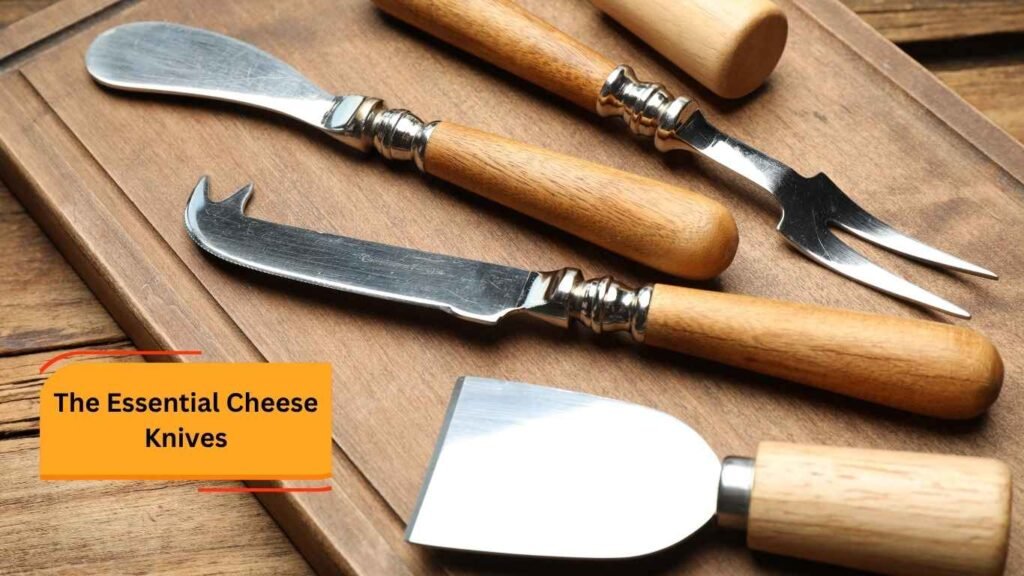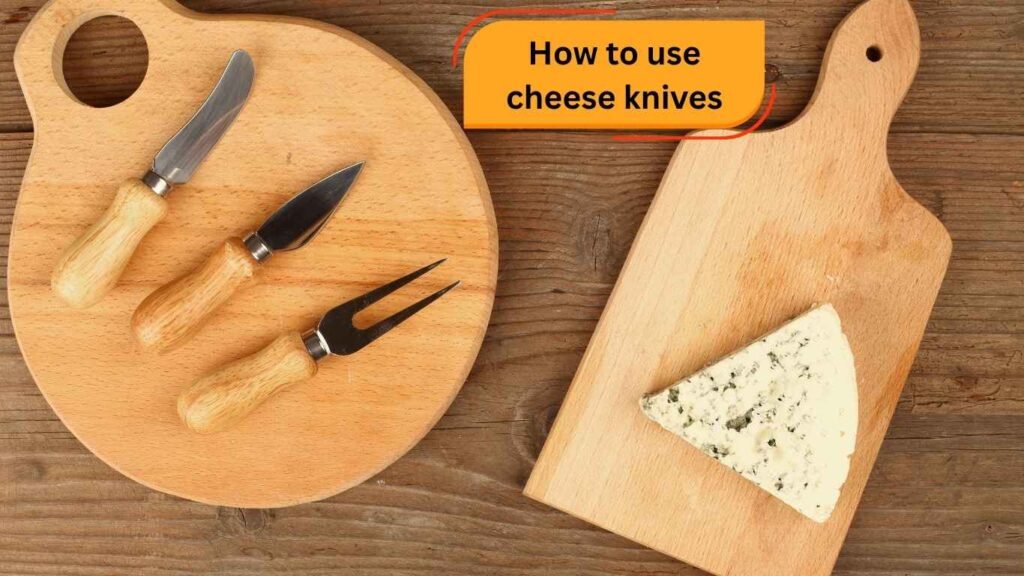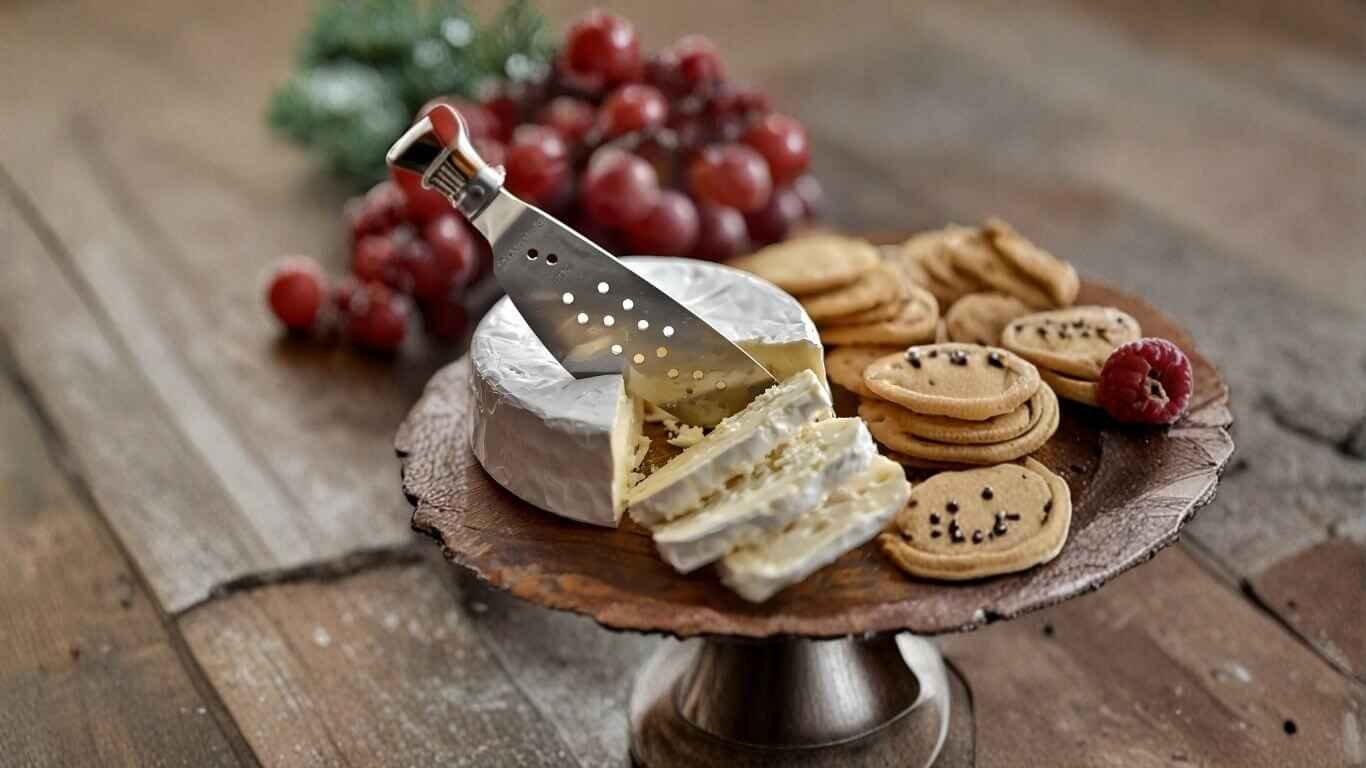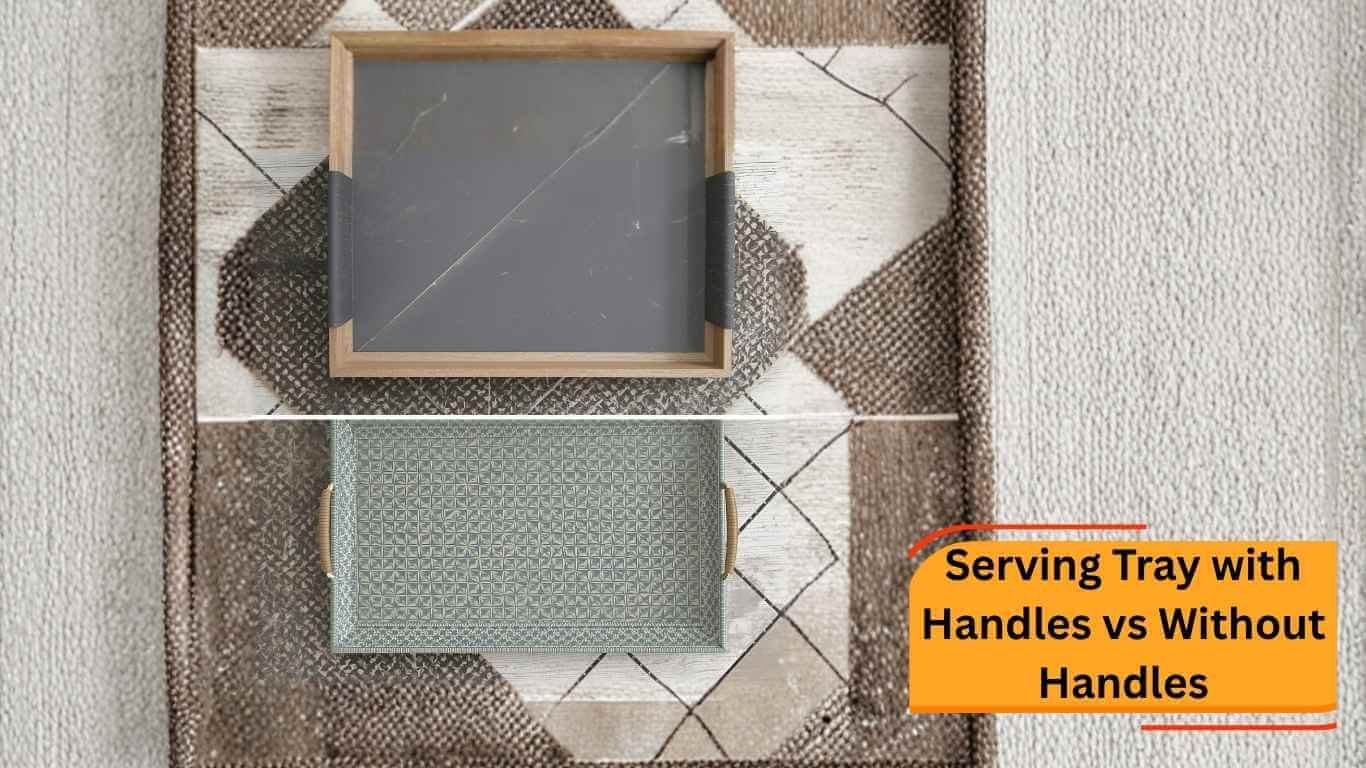Introduction: Unlock the Secrets to Effortless Cheese Presentation
A beautifully arranged cheese board is a masterpiece of flavors and textures, but taking the first bite can be intimidating for many. It’s easy to feel uncertain when faced with a variety of specialized knives. Could you approach any cheese with the confidence of an experienced cheesemonger, from a creamy Brie to a crystallized Parmigiano-Reggiano?
Using this guide, you’ll discover the secrets to flawless cutting and elegant presentation, transforming uncertainty into skill.
In 2022, cheese consumption in the U.S. will reach an all-time high of nearly 42 pounds per person, making mastering this art increasingly important.
Beyond the Block: Why Specialized Knives Matter for the True Cheese Lover
Cheeses that are delicate soft or dense can be frustrating to cut with a standard kitchen knife. By using the wrong tool, cheese can be crushed, smudged, or fractured, compromising its texture and aesthetic appeal. Cheese knives are not luxury items; they are precision instruments designed to respect each cheese’s unique structure. Every knife is designed to glide through specific textures, ensuring that every slice or chunk is exactly as intended by the maker. It preserves the integrity of the cheese, which directly impacts its flavor release and mouthfeel.
The Promise: Cultivating Confidence in Every Cut, Ensuring Elegance in Every Serve
This guide will demystify your cheese knife set, moving you from hesitation to mastery. We will explore the essential tools, master the techniques for cutting every type of cheese, and learn the principles of beautiful presentation. By the end, you will not only understand which knife to use but why it is the perfect tool for the job. You will be empowered to cut with confidence, serve with elegance, and elevate every cheese experience, turning a simple cheese board into a memorable culinary event.
Decoding Your Arsenal: The Essential Cheese Knives & Their Mastery
Understanding your tools is the first step toward cutting with confidence. Cheese knives in well-curated sets are tailored to the density, moisture, and texture of the cheese they are meant to cut.
The Soft Cheese Specialists: For Creamy Delights
Cheeses like Brie, Camembert, or fresh Mozzarella are notorious for sticking to blades. Specific design features address this challenge in the ideal soft cheese knife. Long, thin blades are typically found with holes or perforations. By reducing the surface area, these cutouts minimize drag and prevent the creamy paste from sticking to the knife.
As a result, the cheese holds its delicate shape and is clean and smear-free. In some versions, the slice can be cut and gracefully lifted and served without a separate utensil by using a pronged tip. Very soft, spreadable cheeses can also be spread with a butter knife or cheese spreader.
Conquering Hard & Crumbly Cheeses: Power & Precision
A completely different approach is required for hard cheeses. It’s not a good idea to slice aged Parmesan with a flimsy knife because it will end up with a broken blade and mangled cheese. For these dense, often crumbly varieties, leverage is crucial. The spade knife (or Parmesan knife) is the quintessential tool for this job, since it has a short, sharp, dagger-like blade.
In place of slicing, it is used to score the rind and then cut off rustic, bite-sized chunks that honor the cheese’s natural crystalline structure. A heavy-duty, flat-edged cleaver or chisel knife is the best tool for making clean, straight cuts on cheeses like an aged cheddar without causing the cheese to shatter uncontrollably.
The Versatile All-Rounders & Specialized Tools: For Everyday & Extraordinary Elegance
A versatile knife is your best friend when it comes to semi-hard cheeses, such as Gouda, Provolone, or Swiss. The pronged-tip knife is a popular all-rounder, sharp enough to slice through firm textures yet delicate enough not to damage them. Its forked end makes it ideal for serving. In addition to this tool, a cheese fork is also essential.
The fork is used not for cutting cheese, but rather for holding it steady while you slice with another knife. It is the professional’s choice to use a cheese wire for cheeses that are exceptionally soft or sticky, such as pungent blue cheeses. It glides through the delicate paste with minimal resistance, creating a perfectly clean cut without compressing it.

The Art of Confident Cutting: Techniques for Flawless Presentation
With the right knives identified, the next step is mastering the techniques to use them effectively. Proper cutting technique is about more than just portioning; it’s about respecting the cheese and setting the stage for a beautiful presentation.
Foundation First: Preparing Your Workspace for Success
Before you make the first cut, ensure your setup is stable and safe. Use a solid, non-slip cutting board—wood or bamboo are excellent choices as they are gentle on your knife blades. Make sure your cheese has had time to temper by sitting at room temperature for 30-60 minutes before serving. This “blooming” process enhances the cheese’s flavor and aroma and makes it easier to cut. Arrange your selected knives near the cheeses they will be used for, creating an organized and efficient workspace.
Mastering the Slice: Techniques for Every Texture & Cheese Structure
The shape of the cheese often dictates the cutting technique. The goal is to ensure each guest receives a portion that includes a fair share of the rind and the paste, from the center to the edge.
- Wedges (Brie, Gouda): Slice lengthwise from the thin tip to the thick, rind-covered back, creating long, triangular pieces.
- Rounds (Camembert): Cut like a cake, slicing from the center outwards into even wedges.
- Blocks (Cheddar, Provolone): Cut the block into long, rectangular slices first. Then, you can cut these slices into smaller cubes or sticks for easy serving on crackers.
- Logs (Goat Cheese): Use a cheese wire or unflavored dental floss for the cleanest cuts. Gently loop the wire around the log and pull through in a single, smooth motion.
- Crumbly (Parmigiano, Aged Gouda): Use a spade knife to score the surface and then gently pry off rustic, uneven chunks. Don’t try to create perfect slices.
Troubleshooting Common Cheese Cutting Challenges
Even with the right tools, issues can arise. If your soft cheese is sticking, the blade may not be thin enough, or the cheese may be too warm. Try chilling the knife in ice water for a moment before cutting. If a hard cheese is shattering excessively, it might be too cold. Allowing it a little more time at room temperature can make it more pliable. For a stubborn rind that won’t cut, use the sharp tip of a spade or hard cheese knife to score it deeply before applying pressure to cut through.
The “Cheesemonger’s Secret” to a Clean Cut
Professionals know that a clean knife is key to a clean cut. When portioning multiple cheeses, always wipe your knife blade with a damp cloth between each one. This prevents the transfer of flavors and molds from, for example, a pungent blue cheese to a delicate Mozzarella. For particularly sticky cheeses, lightly oiling the blade with a neutral oil can also help it glide through without resistance, ensuring a pristine slice every time.
Elevating Your Serve: Crafting a Visually Stunning & Functional Cheese Board
The final act of cheese mastery lies in the presentation. A well-crafted cheese board is a feast for the eyes before it ever touches the palate, and the right knives are an integral part of that visual and functional appeal.
Beyond the Cut: Why Presentation Matters
Presentation transforms a simple snack into a sophisticated experience. The way cheese is cut and arranged influences how it is perceived and enjoyed. Thoughtful arrangement invites guests to explore, making the board interactive and engaging. The growing interest in high-quality products, with the specialty cheese market projected to reach USD 53.89 billion by 2030, shows that consumers appreciate these elevated experiences. Each knife, placed correctly, acts as a guide, signaling to guests how to best approach and serve each cheese.
Aesthetic Principles for an Elegant Arrangement
Create visual interest by varying the shapes and positions of your cheeses on the board. Place a wedge of Parmesan next to a round of Brie, and a block of cheddar near a log of goat cheese. Leave enough space between each cheese for cutting and serving. Arrange the knives with their corresponding cheeses, pointing the blade or tip towards the cheese it is intended for. This creates an intuitive flow for your guests. Use small bowls for accompaniments like olives or jams to contain them and add height and dimension to your board.
Seamless Serving: Guiding Guests to Enjoy
To make your cheese board approachable, consider making the first cut in each cheese. This breaks the ice and shows guests how to portion it correctly without them feeling hesitant. For example, pre-slice a few pieces from a block of Gouda or cut a single wedge from a wheel of Brie. Ensure there is at least one dedicated knife for each cheese to prevent flavor cross-contamination. This simple step empowers guests to serve themselves confidently.
Pairing Perfection: How Knives Enhance the Cheese Tasting Journey
The right cut, enabled by the right knife, directly enhances the tasting experience. A clean slice from a cheese wire preserves the delicate veins in a blue cheese, while a rustic chunk of Parmigiano broken by a spade knife showcases its granular texture. These details matter. When cheese is served correctly, its full range of flavors and textures can be appreciated, especially when paired with crackers, fruit, or wine. As 68% of adults consume cheese daily, providing an optimal tasting experience has broad appeal.
Curating Your Collection: Building the Essential Cheese Knife Set
Building a functional and elegant collection of cheese knives doesn’t have to be complicated. You can start with a few essentials and expand over time as your passion for cheese grows.
Your Starter Kit: Must-Have Knives for Every Occasion
For most home entertainers, a complete cheese knife set of three to four pieces is sufficient to handle a wide variety of cheeses. A foundational set should include:
- A Soft Cheese Knife: A thin, perforated blade for Brie and other creamy cheeses.
- A Spade or Chisel Knife: For breaking apart hard, aged cheeses like Parmesan.
- A Pronged-Tip Knife: A versatile all-rounder for slicing semi-hard cheeses like cheddar and for serving.
- A Cheese Spreader: For soft, spreadable cheeses like chèvre or cream cheese.
Expanding Your Arsenal: Specialty Tools for the Enthusiast
As you delve deeper into the world of cheese, you may want to add more specialized tools. A cheese wire is an excellent addition for those who frequently enjoy very soft or blue cheeses. A cheese plane creates elegant, paper-thin slices from semi-hard cheeses like Jarlsberg or Gouda, which can alter the tasting experience by allowing the flavor to melt on the tongue. For the true connoisseur, a two-handled knife provides maximum leverage for splitting large wheels of hard cheese.
Care and Maintenance for Lasting Elegance
To ensure your cheese knives last a lifetime, proper care is essential. Always hand wash your knives with warm, soapy water and dry them immediately. Never put them in the dishwasher, as the harsh detergents and high heat can damage the blades and handles, especially if they are made of wood. Store them in a knife block, on a magnetic strip, or in a divided drawer to protect the blades from dulling or chipping.
Conclusion: Your Journey to Cheese Knife Mastery
What began as a simple guide to tools has become a journey into the art and science of enjoying cheese to its fullest. By understanding the purpose behind each knife and mastering the techniques for each texture, you have unlocked the ability to present cheese with confidence and style.
Recap: From Intimidation to Inspiration – The Transformation of Your Cheese Experience
We’ve moved beyond the confusion of a mismatched set of tools. You now know that a soft cheese knife protects delicate textures, a spade knife respects the crystalline structure of aged cheeses, and a versatile pronged knife can anchor any cheese board. This knowledge is the foundation of confident serving.
Practice Makes Perfect: Continual Improvement of Your Skills
Like any craft, cheese cutting improves with practice. The next time you assemble a cheese board, consciously select your knives and think about the best way to portion each cheese. Experiment with different cuts and arrangements. With each board you create, your movements will become more fluid and your presentations more refined.
Embrace the Experience: The Joy of Confident Cutting & Elegant Serving – a Skill that Elevates Every Cheese Occasion.
You are now equipped with the skills of a gracious host and a knowledgeable cheese enthusiast. The true joy comes from sharing this experience with others, watching guests interact with a beautifully presented, functional, and delicious cheese board. This is more than just cutting cheese; it’s about crafting moments, facilitating discovery, and celebrating the simple, profound pleasure of good food shared with good company.



